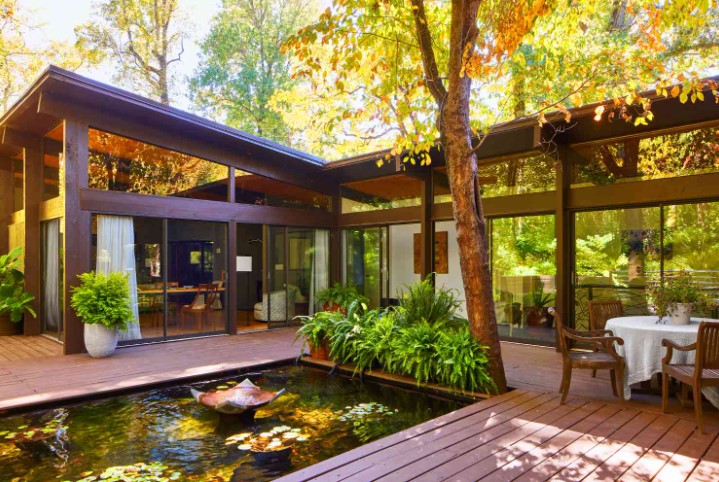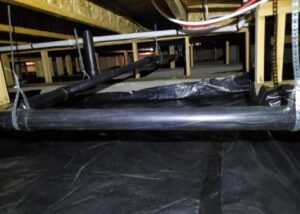Midcentury Modern House Style

Introduction
What comes to mind when you hear “midcentury modern house style“? Perhaps it’s the sleek lines, large windows, and integration with nature. This timeless design aesthetic, rooted in the mid-20th century, has captivated architects, designers, and homeowners alike for decades. But what makes it so enduringly popular?
History of Midcentury Modern House Style
Origins and Evolution
The midcentury modern movement emerged in the aftermath of World War II, a period marked by optimism and innovation. Spanning roughly from the mid-1940s to the late 1960s, this design style was heavily influenced by the Bauhaus and International movements, emphasizing simplicity, functionality, and a connection to the environment.
Key Influencers
Architects like Frank Lloyd Wright, Ludwig Mies van der Rohe, and Richard Neutra played pivotal roles in shaping midcentury modern architecture. Their work emphasized harmony between human habitation and the natural world, a principle that remains a cornerstone of midcentury modern design.
Characteristics of Midcentury Modern Houses
Simple and Clean Lines
One of the defining features of midcentury modern homes is their simple, clean lines. This minimalist approach avoids unnecessary ornamentation, focusing instead on sleek, streamlined forms.
Integration with Nature
Midcentury modern homes are designed to blend seamlessly with their surroundings. Large windows and open floor plans create a sense of harmony with the outdoor environment, inviting nature inside.
Functional Design
Functionality is at the heart of midcentury modern design. Every element of the house is designed with purpose, ensuring that form follows function without sacrificing aesthetic appeal.
Use of Glass and Open Spaces
Expansive glass walls and open spaces are hallmarks of midcentury modern homes. These features not only maximize natural light but also create a sense of openness and fluidity between indoor and outdoor spaces.
Exterior Features
Flat Planes and Geometric Forms
Midcentury modern houses often feature flat planes and geometric forms. These elements contribute to the sleek, uncluttered look that defines the style.
Large Windows and Glass Walls
Large windows and glass walls are essential components of midcentury modern design. They provide unobstructed views of the outdoors and enhance the feeling of spaciousness.
Integration with the Landscape
Landscaping is an integral part of midcentury modern architecture. These homes are often set within carefully designed gardens that complement their clean lines and minimalist aesthetics.
Interior Features
Open Floor Plans
Open floor plans are a staple of midcentury modern interiors. This design choice fosters a sense of community and allows for flexible use of space.
Minimalist Aesthetics
Inside, midcentury modern homes are characterized by minimalist aesthetics. The focus is on functionality and simplicity, with a preference for uncluttered spaces.
Bold Use of Color and Materials
While the overall design is minimalist, midcentury modern homes often incorporate bold colors and a variety of materials. This contrast adds visual interest and warmth to the interiors.
Iconic Furniture and Decor
Midcentury modern furniture and decor have become iconic in their own right. Pieces by designers like Charles and Ray Eames, Eero Saarinen, and George Nelson are celebrated for their innovative and timeless designs.
Key Elements in Midcentury Modern Design
Furniture
Furniture in midcentury modern homes is characterized by clean lines, organic shapes, and innovative materials. Think of the Eames Lounge Chair or the Noguchi Coffee Table as quintessential examples.
Lighting
Lighting plays a crucial role in midcentury modern design. From sleek floor lamps to sculptural chandeliers, the lighting fixtures are both functional and artistic.
Materials and Textures
Wood, metal, and glass are commonly used materials in midcentury modern homes. These materials are often left in their natural state to highlight their inherent beauty.
Color Palette
The midcentury modern color palette ranges from neutral tones to bold, vibrant hues. Earthy colors like olive green, mustard yellow, and burnt orange are often used to create a warm, inviting atmosphere.
Influence on Contemporary Architecture
Lasting Impact on Modern Design
The principles of midcentury modern design continue to influence contemporary architecture. Its emphasis on simplicity, functionality, and integration with nature resonates with modern sensibilities.
Revival and Adaptation in Contemporary Homes
Many contemporary homes draw inspiration from midcentury modern design. Whether through architectural elements, interior decor, or landscaping, the midcentury modern aesthetic remains relevant and appealing.
Famous Midcentury Modern Architects
Richard Neutra
Richard Neutra was known for his innovative use of glass and his commitment to creating harmonious relationships between architecture and nature.
Ludwig Mies van der Rohe
Ludwig Mies van der Rohe’s mantra “less is more” perfectly encapsulates the midcentury modern ethos. His work is celebrated for its simplicity and elegance.
Charles and Ray Eames
Charles and Ray Eames made significant contributions to midcentury modern design through their innovative furniture and architectural designs.
Preserving Midcentury Modern Homes
Importance of Preservation
Preserving midcentury modern homes is vital for maintaining their historical and architectural significance. These homes are a testament to a pivotal period in design history.
Tips for Maintaining Authenticity
When preserving a midcentury modern home, it’s essential to respect the original design. This includes using period-appropriate materials and maintaining the home’s distinctive architectural features.
Decorating a Midcentury Modern Home
Choosing the Right Furniture
Select furniture that embodies the clean lines and organic shapes characteristic of midcentury modern design. Pieces from the era or high-quality reproductions can help achieve an authentic look.
Balancing Function and Aesthetics
Striking a balance between function and aesthetics is crucial. Ensure that each piece of furniture serves a purpose while contributing to the overall design scheme.
Incorporating Vintage Pieces
Incorporating vintage midcentury modern pieces can add character and authenticity to your home. Look for well-preserved items that showcase the era’s distinctive style.
Renovating Midcentury Modern Homes
Respecting the Original Design
When renovating a midcentury modern home, it’s important to honor the original design. This means preserving key architectural elements and using materials that are true to the period.
Modern Upgrades and Enhancements
While maintaining the home’s original character, consider modern upgrades that enhance functionality and comfort. This could include energy-efficient windows, updated plumbing, and smart home technology.
Midcentury Modern in Popular Culture
Influence in Movies and Television
Midcentury modern design has left a lasting imprint on popular culture. Iconic TV shows and movies, such as “Mad Men,” have showcased the style, further cementing its place in the public imagination.
Midcentury Modern in Today’s Lifestyle
Today, midcentury modern design is embraced by a new generation of homeowners and designers. Its timeless appeal and versatility make it a popular choice for those seeking a stylish, functional living environment.
Benefits of Midcentury Modern Design
Timeless Appeal
One of the greatest strengths of midcentury modern design is its timeless appeal. The clean lines, functional spaces, and harmonious integration with nature ensure that it remains relevant and stylish.
Versatility and Adaptability
Midcentury modern design is incredibly versatile and adaptable. It can be incorporated into various architectural styles and interior design schemes, making it a flexible choice for homeowners.
Challenges of Midcentury Modern Homes
Common Issues and How to Address Them
Like any architectural style, midcentury modern homes come with their own set of challenges. These can include outdated systems, structural issues, and the need for careful preservation of original features.
Balancing Modern Needs with Classic Design
Balancing modern needs with classic design elements can be tricky. However, with thoughtful planning and a commitment to preserving the home’s integrity, it’s possible to create a space that honors the past while embracing the future.
Conclusion
The enduring legacy of midcentury modern house style lies in its perfect balance of form and function, its celebration of simplicity, and its deep connection to the natural world. Whether you’re a longtime enthusiast or new to the style, midcentury modern design offers a timeless and versatile approach to creating beautiful, functional living spaces.
FAQs
What Defines Midcentury Modern Style?
Midcentury modern style is defined by its clean lines, functional design, integration with nature, and use of natural materials and bold colors.
How Can I Incorporate Midcentury Modern Elements into My Home?
Incorporate midcentury modern elements by selecting furniture with clean lines, using natural materials, and maintaining a minimalist aesthetic.
Are Midcentury Modern Homes Energy Efficient?
Many midcentury modern homes can be energy efficient, especially with updates such as energy-efficient windows and improved insulation.
What Are Some Affordable Midcentury Modern Furniture Options?
Affordable midcentury modern furniture options include vintage finds at thrift stores, high-quality reproductions, and pieces from contemporary designers inspired by the era.
How Can I Find a Midcentury Modern Home?
To find a midcentury modern home, consider working with a real estate agent who specializes in historical homes, or look for listings in neighborhoods known for their midcentury architecture.






